Java深入浅出说流的使用
一、File类的使用
1.File类的一个对象,代表一个文件或一个文件目录(俗称:文件夹)
2.File了声明在java.io包下
3.File类中涉及到关于文件或文件目录的创建、删除、重命名、修改时间、文件大小等方法。
并涉及到写入或读取文件内容的操作。入宫需要读取或写入文件内容,必须使用IO流来完成。
4.后续File类的对象常会作为参数传递到流的构造器中,指明读取或写入的"终点"。
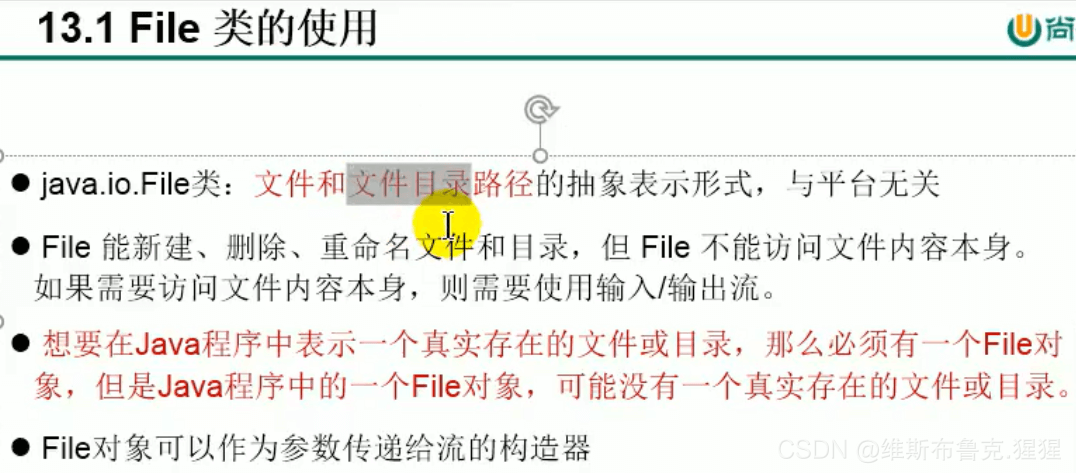
A.常用构造器

B.路径分隔符
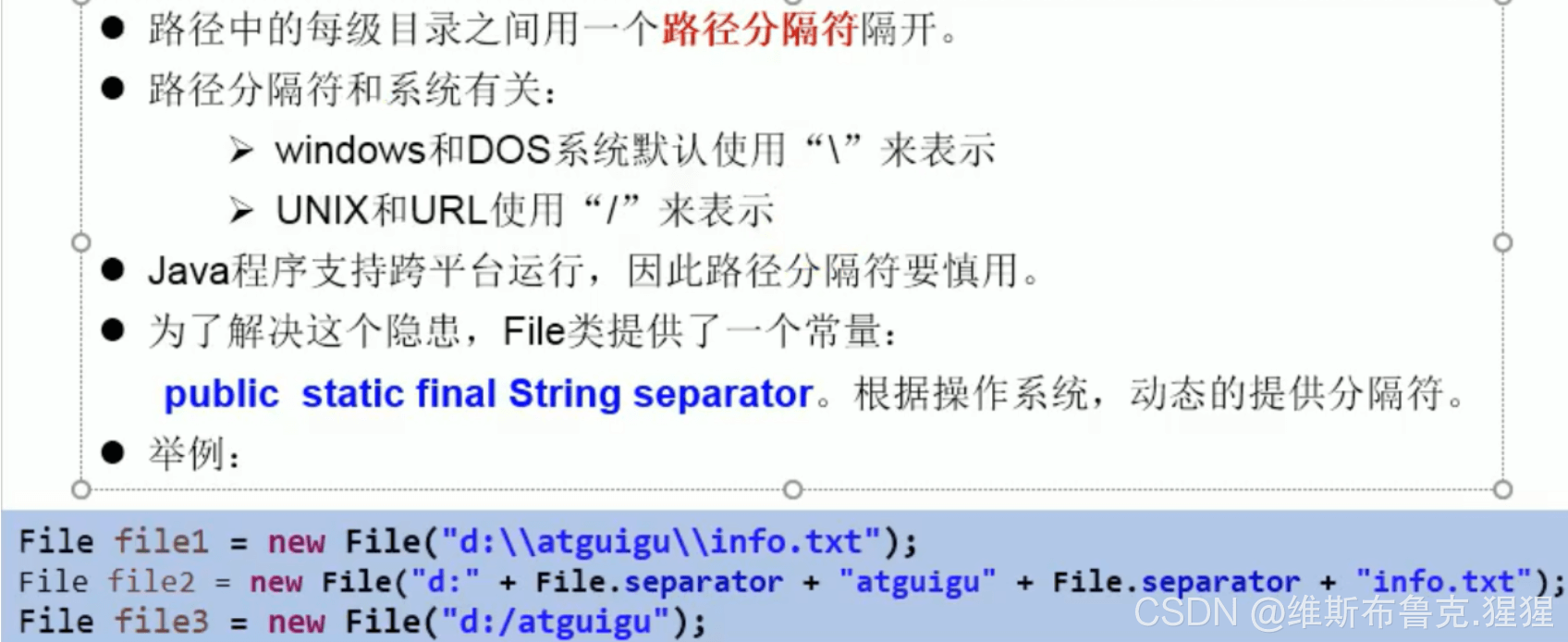
/*
1.如何创建File类的实例
File(String filePath)
File(String parentPath,String,childPath)
File(File parentFile,String childPath)
2.相对路径:相较于某个路径下,知名的路径。
绝对路径:包含盘符在内的未见或文件目录的路径
3.路径分隔符
windows:\\
unix:/
*/
public void test1() {
//构造器1
File file1 = new File("hello.txt");//相对于module
File file2 = new File("E:\\zxdym\\IDEA\\code\\JavaSenior\\2021_08\\he.txt");
System.out.println(file1);
System.out.println(file2);
//构造器2
File file3 = new File("E:\\zxdym\\IDEA\\code", "JavaSenior");
System.out.println(file3);
//构造器3
File file4 = new File(file3, "hi.txt");
System.out.println(file4);
}
C.常用方法
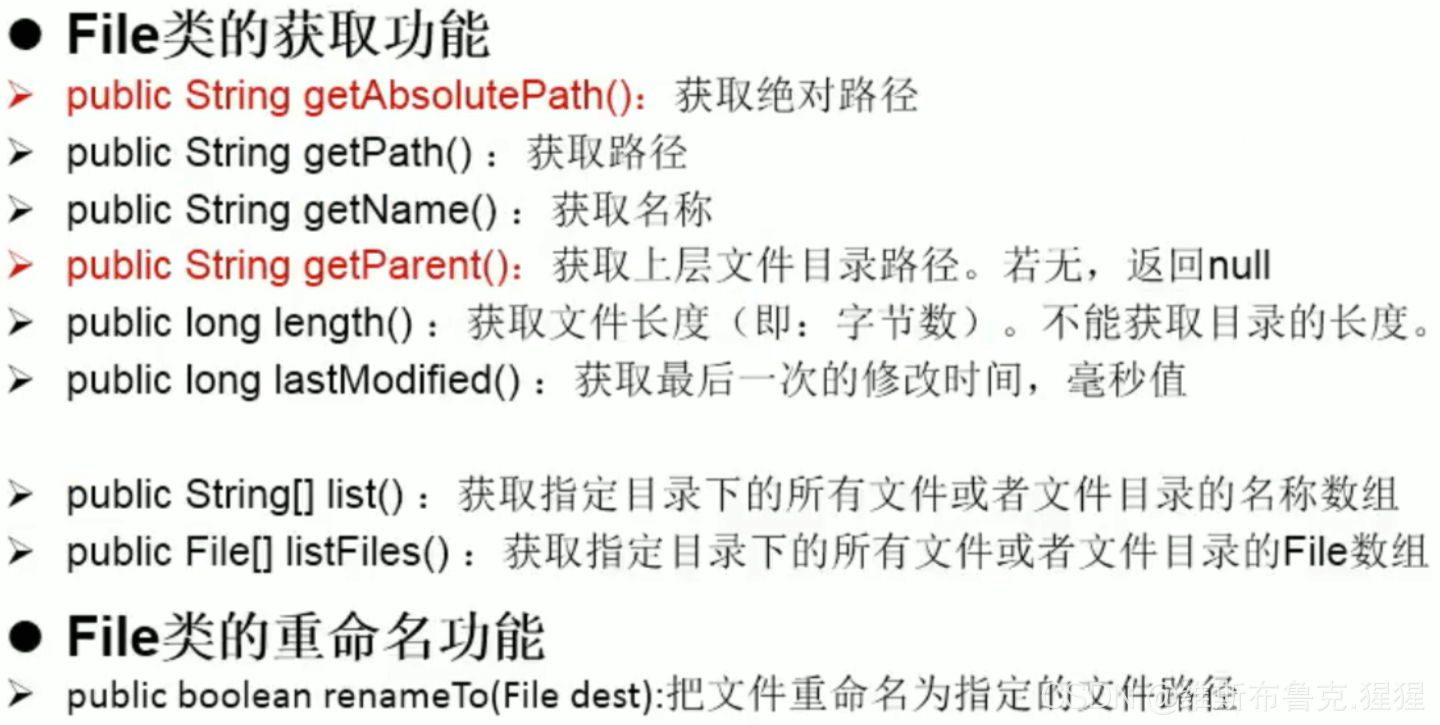
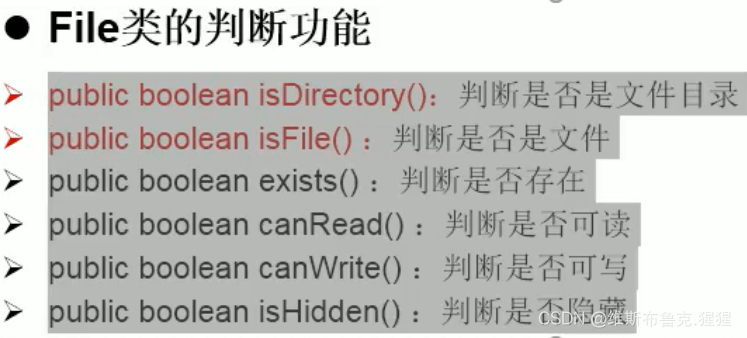
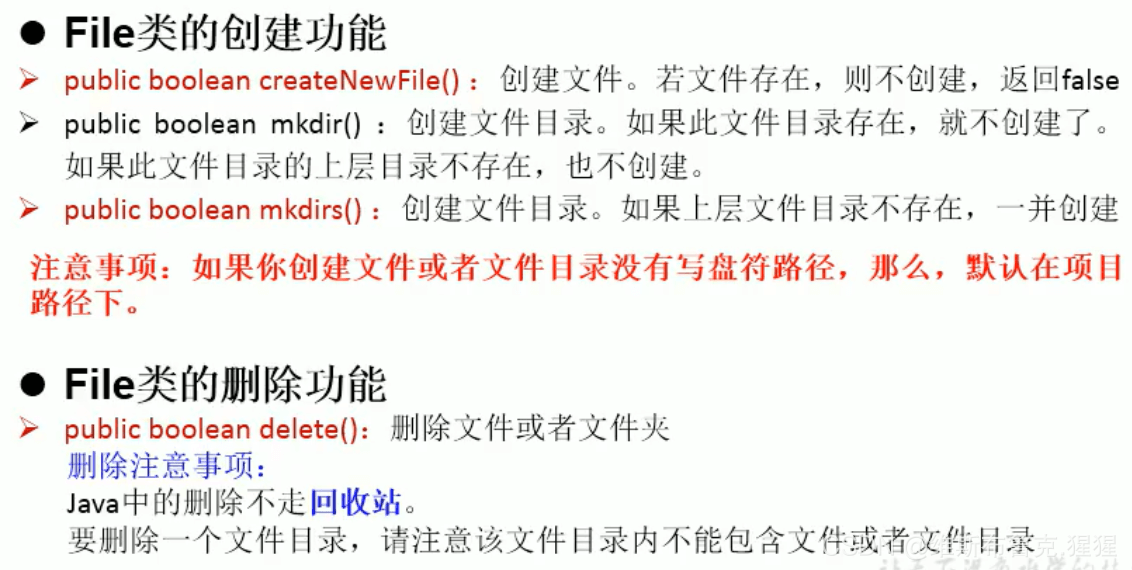
public void test2() {
File file1 = new File("hello.txt");
File file2 = new File("d:\\io\\hi.txt");
System.out.println(file1.getAbsolutePath());
System.out.println(file1.getPath());
System.out.println(file1.getName());
System.out.println(file1.getParent());
System.out.println(file1.length());
System.out.println(new Date(file1.lastModified()));
System.out.println();
System.out.println(file2.getAbsolutePath());
System.out.println(file2.getPath());
System.out.println(file2.getName());
System.out.println(file2.getParent());
System.out.println(file2.length());
System.out.println(file2.lastModified());
}
public void test3() {
File file = new File("E:\\\\zxdym\\\\IDEA\\\\code\\\\JavaSenior");
String[] list = file.list();
for (String s : list) {
System.out.println(s);
}
System.out.println();
File[] files = file.listFiles();
for (File f : files) {
System.out.println(f);
}
}
/*
public boolean removeTo(File dest):把文件重命名为指定的文件路径
比如:file1.renameTo(file2)为例:
要想保证返回true,需要file1在硬盘中是存在的,且file2不能在硬盘中存在。
*/
@Test
public void test4() {
File file1 = new File("hello.txt");
File file2 = new File("D:\\io\\hi.txt");
boolean renameTo = file1.renameTo(file2);
System.out.println(renameTo);
}
@Test
public void test5() {
File file1 = new File("hello.txt");
System.out.println(file1.isDirectory());
System.out.println(file1.isFile());
System.out.println(file1.exists());
System.out.println(file1.canRead());
System.out.println(file1.canWrite());
System.out.println(file1.isHidden());
}
@Test
public void test6() throws IOException {
File file1 = new File("hi.txt");
if (!file1.exists()) {
file1.createNewFile();
System.out.println("创建成功");
} else {//文件存在
file1.delete();
System.out.println("删除成功");
}
}
@Test
public void test7(){
//文件目录的创建
File file1 = new File("e:\\io\\io1\\io3");
boolean mkdir = file1.mkdir();
if(mkdir){
System.out.println("创建成功1");
}
File file2 = new File("e:\\io\\io1\\io3");
boolean mkdir1 = file1.mkdirs();
if(mkdir1){
System.out.println("创建成功2");
}
}
D.注意点
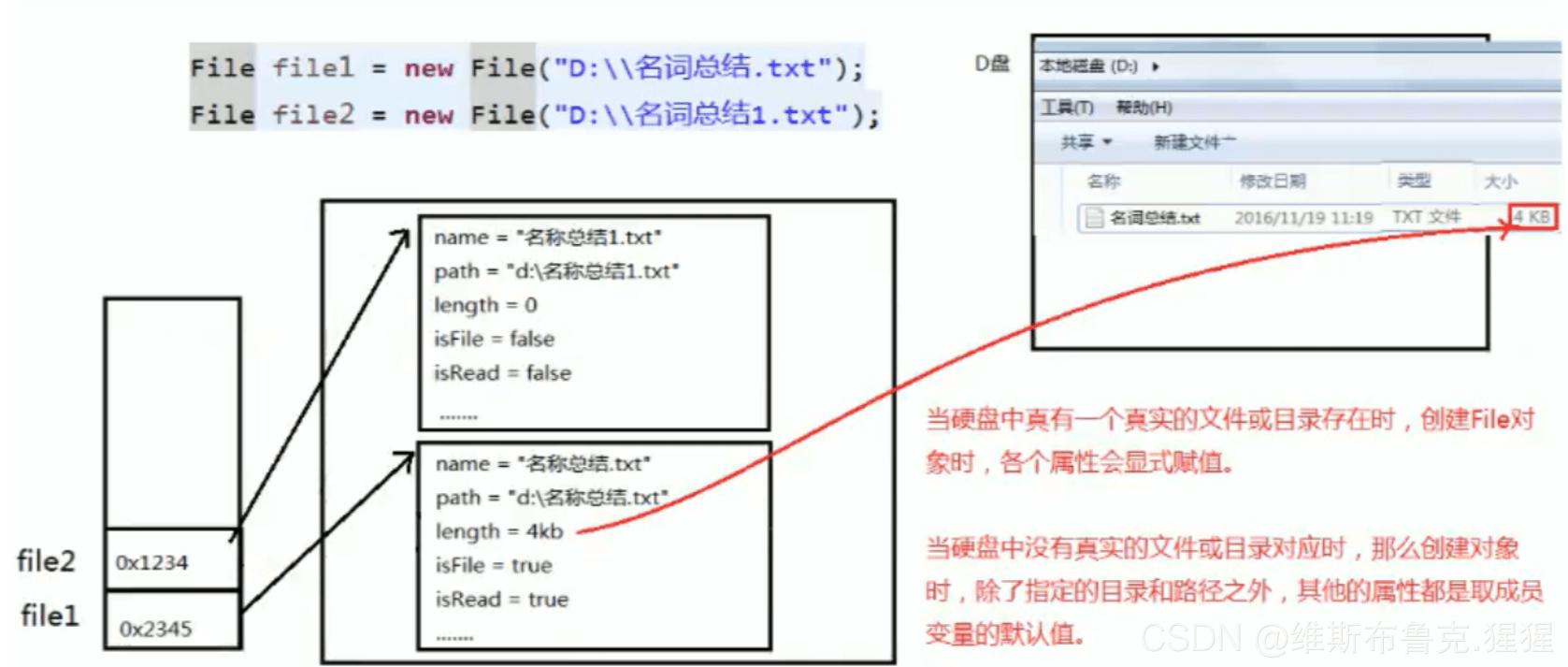
二、流的分类及其体系

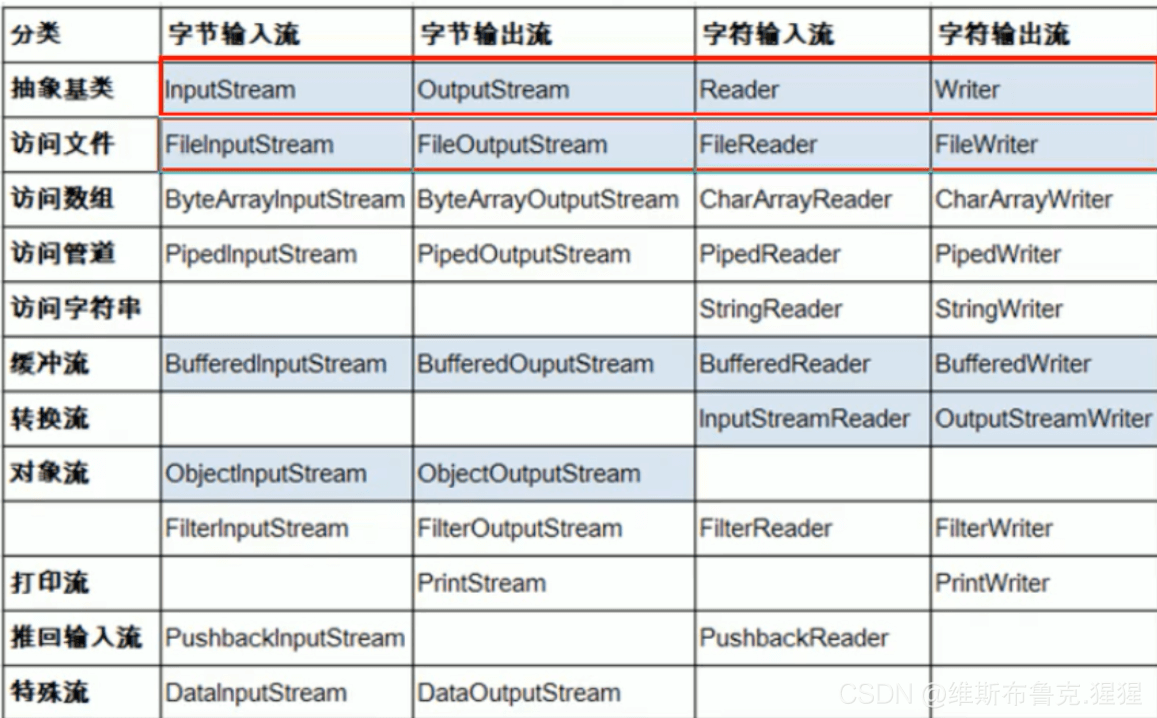
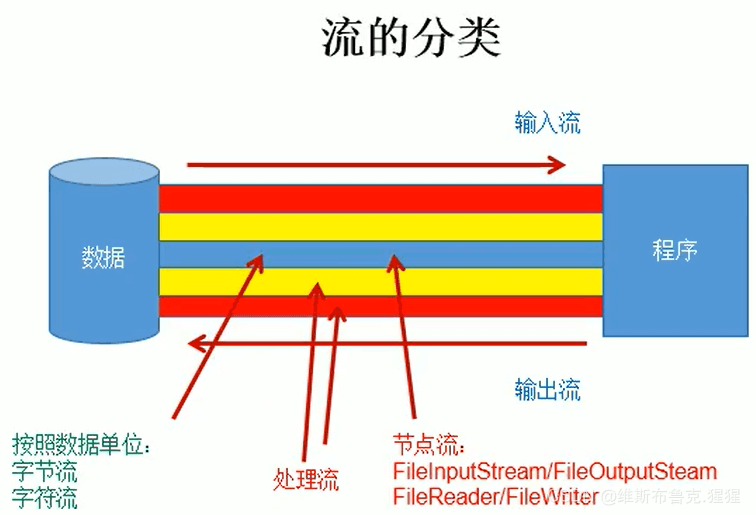
开发中,用缓冲流,效率比节点流高(蓝色框中的表示重要的、常用的)
输入、输出的标准化过程
1.输入过程
A.创建File类的对象,指明读取的数据的来源。(要求此文件一定要存在)
B.创建相应的输入流,将File类的对象作为参数,传入流的构造器中
C.具体的读入过程:
创建相应的byte[] 或 char[]
D.关闭流资源
说明:程序中出现的异常需要使用try-catch-finally处理。
2.输出过程
A.创建File类的对象,指明写出的数据的来源。(要求此文件一定要存在)
B.创建相应的输出流,将File类的对象作为参数,传入流的构造器中
C.具体的写出过程:
write(char[]/byte[] buffer,0,len)
D.关闭流资源
说明:程序中出现的异常需要使用try-catch-finally处理。
public class FileReaderWriterTest {
public static void main(String[] args) {
File file = new File("hello.txt");//相较于前工程
System.out.println(file.getAbsolutePath());
File file1 = new File("2021_08\\hello.txt");
System.out.println(file1.getAbsolutePath());
}
/*
将day09下的hello.txt文件内容读入程序中,并输出到控制台
说明点:
1.read()的理解,返回读入的一个字符,如果达到文件末尾,返回-1
2.异常的处理:为了保证流资源一定可以执行关闭操作。需要使用try-catch-finally处理
3.读入的文件一定要存在,否则就会报FileNotFoundException.
*/
@Test
public void testFileReader(){
FileReader fr = null;
try {
//1.实例化File类的对象,指明要操作的文件
File file = new File("hello.txt");//相较于当前Module
//2.提供具体的流
fr = new FileReader(file);
//3.数据的读入
//read():返回读入的一个字符,如果达到文件末尾,返回-1
//方式一:
// int data = fr.read();
// while(data != -1){
// System.out.print((char)data);
// data = fr.read();
// }
//方式二:语法上针对方式一的修改
int data;
while((data = fr.read()) != -1){
System.out.print((char)data);
}
} catch (IOException e) {
e.printStackTrace();
} finally {
//4.流的关闭操作
try {
if(fr != null)
fr.close();
} catch (IOException e) {
e.printStackTrace();
} finally {
}
}
}
@Test
public void testFileReader1(){
FileReader fr = null;
try {
//1.File类的实例化
File file = new File("hello.txt");
//2.FileReader流的实例化
fr = new FileReader(file);
//3.读入的操作
//read(char[] cbuf):返回每次读入cbuf数组中的字符的个数,如果达到文件末尾,返回-1
char[] cbuf = new char[5];
int len;
while(( len = fr.read(cbuf)) != -1){
//方式一:
//错误的写法//知识点难点:数组元素的覆盖
// for(int i = 0;i < cbuf.length;i++){
// System.out.print(cbuf[i]);
// }
//正确的写法
// for(int i = 0;i < len;i++){
// System.out.print(cbuf[i]);
// }
//方式二:
//错误的写法,对应着方式一的错误的写法
// String str = new String(cbuf);
// System.out.println(str);
//正确的写法
String str = new String(cbuf, 0, len);
System.out.print(str);
}
} catch (IOException e) {
e.printStackTrace();
} finally {
if(fr != null){
//4.资源的关闭
try {
fr.close();
} catch (IOException e) {
e.printStackTrace();
}
}
}
}
/*
从内存中写出数据到硬盘的文件里
说明:
1.输出操作,对应的File可以不存在的,并不会报异常
2.
File对应的硬盘中的文件如果不存在,在输出的过程中,会自动创建此文件
File对应的硬盘中的文件如果存在:
如果流使用的构造器是:FileWriter(file,false) / FileWriter(file):对原有文件的覆盖
如果流使用的构造器是:FileWriter(file,true):不会对原有文件覆盖,而是在原有文件基础上追加内容
*/
@Test
public void testFileWriter() {
FileWriter fw = null;
try {
//1.提供File类的对象,指明写出到的文件
File file = new File("hello1.txt");
//2.提供FileWriter的对象,用于数据的写出
fw = new FileWriter(file,false);
//3.写出的操作
fw.write("I have a dream!\n");
fw.write("you need to have a dream!");
} catch (IOException e) {
e.printStackTrace();
} finally {
//4.流资源的关闭
if(fw != null){
try {
fw.close();
} catch (IOException e) {
e.printStackTrace();
}
}
}
}
@Test
public void testFileReaderFileWriter(){
FileReader fr = null;
FileWriter fw = null;
try {
//1.创建File类的对象,指明读入和写出的文件
File srcFile = new File("hello.txt");
File destFile = new File("hello2.txt");
//不能使用字符流来处理图片等字节数据
// File srcFile = new File("爱情与友情.jpg");
File destFile = new File("爱情与友情1.jpg");
//2.创建数据入流和输出流的对象
fr = new FileReader(srcFile);
fw = new FileWriter(destFile);
//3.数据的读入和写出操作
char[] cbuf = new char[5];
int len;//记录每次读入到cbuf数组中的字符的个数
while((len = fr.read(cbuf)) != -1){
//每次写出len个字符
fw.write(cbuf,0,len);
}
} catch (IOException e) {
e.printStackTrace();
} finally {
// //4.关闭流资源
// //方式一:
// try {
// fw.close();
// } catch (IOException e) {
// e.printStackTrace();
// }finally {
// try {
// fr.close();
// } catch (IOException e) {
// e.printStackTrace();
// }
// }
//方式二:
try {
fw.close();
} catch (IOException e) {
e.printStackTrace();
}
try {
fr.close();
} catch (IOException e) {
e.printStackTrace();
}
}
}
}
三、流的详细介绍
1.字节流和字符流
测试FileInputStream和FileOutputStream的使用
public class FileInputOutputStreamTest {
//使用字节流FileInputOutputStream处理文本文件,可能出现乱码
@Test
public void testFileInputStream(){
FileInputStream fis = null;
try {
//1.造文件
File file = new File("hello.txt");
//2.造流
fis = new FileInputStream(file);
//3.读数据
byte[] buffer = new byte[5];
int len;//记录每次读取的字节的个数
while((len = fis.read(buffer)) != -1){
String str = new String(buffer, 0, len);
System.out.print(str);
}
} catch (IOException e) {
e.printStackTrace();
} finally {
//4.关闭资源
try {
fis.close();
} catch (IOException e) {
e.printStackTrace();
}
}
}
/*
实现对图片的复制操作
*/
@Test
public void testFileInputOutputStream(){
FileInputStream fis = null;
FileOutputStream fos = null;
try {
File srcFile = new File("爱情与友情.jpg");
File destFile = new File("爱情与友情2.jpg");
fis = new FileInputStream(srcFile);
fos = new FileOutputStream(destFile);
//复制的过程
byte[] buffer = new byte[5];
int len;
while((len = fis.read(buffer)) != -1){
fos.write(buffer,0,len);
}
} catch (IOException e) {
e.printStackTrace();
} finally {
if(fos != null){
try {
fos.close();
} catch (IOException e) {
e.printStackTrace();
}
}
if(fis != null){
try {
fis.close();
} catch (IOException e) {
e.printStackTrace();
}
}
}
}
//指定路径下文件的复制
public void copyFile(String srcPath,String destPath){
FileInputStream fis = null;
FileOutputStream fos = null;
try {
File srcFile = new File(srcPath);
File destFile = new File(destPath);
fis = new FileInputStream(srcFile);
fos = new FileOutputStream(destFile);
//复制的过程
byte[] buffer = new byte[5];
int len;
while((len = fis.read(buffer)) != -1){
fos.write(buffer,0,len);
}
} catch (IOException e) {
e.printStackTrace();
} finally {
if(fos != null){
try {
fos.close();
} catch (IOException e) {
e.printStackTrace();
}
}
if(fis != null){
try {
fis.close();
} catch (IOException e) {
e.printStackTrace();
}
}
}
}
@Test
public void testCopyFile(){
long start = System.currentTimeMillis();
String srcPath = "C:\\Users\\Administrator\\Desktop\\01-视频.avi";
String destPath = "C:\\Users\\Administrator\\Desktop\\02-视频.avi";
copyFile(srcPath,destPath);
long end = System.currentTimeMillis();
System.out.println("复制操作花费的时间为:" + (end - start));
}
}
结论:
1.对于文本文件(.txt,.java,.c,.cpp),使用字符流处理
2.对于非文本文件(.jpg,.mp3,.mp4,.avi,.doc,.ppt,...),使用字节流处理
2.节点流和处理流(重点)
处理流之一:缓冲流的作用
1.缓冲流:
BufferedInputStream
BufferedOutputStream
BufferedReader
BufferedWriter
2.作用:提高流的读取,写入的速度
提高读写速度的原因:内部提供了一个缓冲区,默认情况是8kb
3.处理流:就是"套接"在已有流的基础上
public class BufferedTest {
@Test
public void BufferedStreamTest(){
BufferedInputStream bis = null;
BufferedOutputStream bos = null;
try {
//1.造文件
File srcFile = new File("爱情与友情.jpg");
File destFile = new File("爱情与友情3.jpg");
//2.造流
//2.1造节点流
FileInputStream fis = new FileInputStream(srcFile);
FileOutputStream fos = new FileOutputStream(destFile);
//2.2造缓冲流
bis = new BufferedInputStream(fis);
bos = new BufferedOutputStream(fos);
//3.复制的细节:读取、写入
byte[] buffer = new byte[10];
int len;
while((len = bis.read(buffer)) != -1){
bos.write(buffer,0,len);
// bos.flush();//刷新缓冲区
}
} catch (IOException e) {
e.printStackTrace();
} finally {
//4.资源关闭
//要求:先关闭外层的流,再关闭内层的流
if(bos != null){
try {
bos.close();
} catch (IOException e) {
e.printStackTrace();
}
}
if(bis != null){
try {
bis.close();
} catch (IOException e) {
e.printStackTrace();
}
}
//说明:关闭外层流的同时,内层流也会自动的进行关闭,关于内层流的关闭,可以省略
// fos.close();
// fis.close();
}
}
@Test
public void testCopyFileWithBuffered(){
long start = System.currentTimeMillis();
String srcPath = "C:\\Users\\Administrator\\Desktop\\01-视频.avi";
String destPath = "C:\\Users\\Administrator\\Desktop\\03-视频.avi";
copyFileWithBuffered(srcPath,destPath);
long end = System.currentTimeMillis();
System.out.println("复制操作花费的时间为:" + (end - start));
}
//实现文件复制的方法
public void copyFileWithBuffered(String srcPath,String destPath) {
BufferedInputStream bis = null;
BufferedOutputStream bos = null;
try {
//1.造文件
File srcFile = new File(srcPath);
File destFile = new File(destPath);
//2.造流
//2.1造节点流
FileInputStream fis = new FileInputStream(srcFile);
FileOutputStream fos = new FileOutputStream(destFile);
//2.2造缓冲流
bis = new BufferedInputStream(fis);
bos = new BufferedOutputStream(fos);
//3.复制的细节:读取、写入
byte[] buffer = new byte[10];
int len;
while ((len = bis.read(buffer)) != -1) {
bos.write(buffer, 0, len);
}
} catch (IOException e) {
e.printStackTrace();
} finally {
//4.资源关闭
//要求:先关闭外层的流,再关闭内层的流
if (bos != null) {
try {
bos.close();
} catch (IOException e) {
e.printStackTrace();
}
}
if (bis != null) {
try {
bis.close();
} catch (IOException e) {
e.printStackTrace();
}
}
//说明:关闭外层流的同时,内层流也会自动的进行关闭,关于内层流的关闭,可以省略
// fos.close();
// fis.close();
}
}
/*
使用BufferedReader和BufferedWriter实现文本文件的复制
*/
@Test
public void testBufferedReaderBufferedWriter(){
BufferedReader br = null;
BufferedWriter bw = null;
try {
//创建文件和相应的流
br = new BufferedReader(new FileReader(new File("dpcp.txt")));
bw = new BufferedWriter(new FileWriter(new File("dpcp1.txt")));
//读写操作
//方式一:使用char[]数组
// char[] cbuf = new char[1024];
// int len;
// while((len = br.read(cbuf)) != -1){
// bw.write(cbuf,0,len);
// }
//方式二:使用String
String data;
while((data = br.readLine()) != null){
//方法一:
bw.write(data + "\n");//data中不包含换行符
//方法二:
bw.write(data);//data中不包含换行符
bw.newLine();//提供换行的操作
}
} catch (IOException e) {
e.printStackTrace();
} finally {
//关闭资源
if(bw != null){
try {
bw.close();
} catch (IOException e) {
e.printStackTrace();
}
}
if(br != null){
try {
br.close();
} catch (IOException e) {
e.printStackTrace();
}
}
}
}
}
处理流之二:转换流的使用(重点)
1.转换流:属于字符流
InputStreamReader:将一个字节的输入流转换为字符的输入流
OutputStreamWriter:将一个字符的输出流转换为字节的输出流
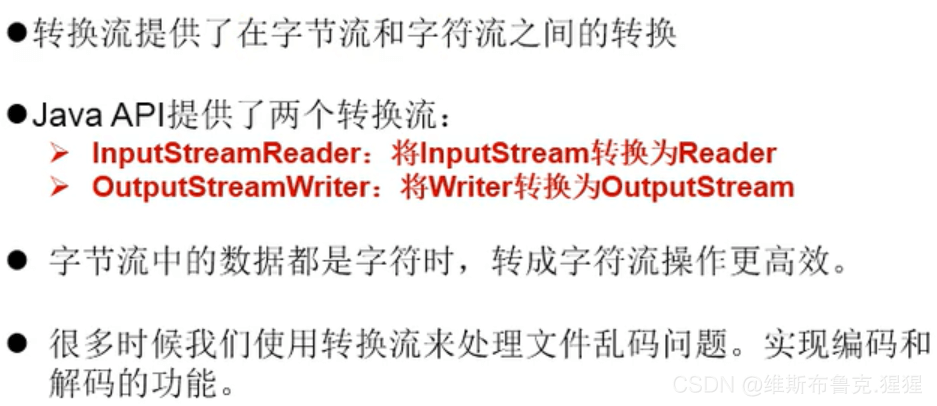

2.作用:提供字节流与字符流之间的转换
3.解码:字节、字节数组 ---> 字符数组、字符串
编码:字符数组、字符串---> 字节、字节数组
说明:编码决定了解码的方式
4.字符集
说明:文件编码的方式(比如:GBK),决定了解析时使用的字符集(也只能是GBK)
public class InputStreamReaderTest {
/*
此时处理异常的话,仍然应该使用try-catch-finally
*/
@Test
public void test1() throws IOException{
FileInputStream fis = new FileInputStream("dbcp.txt");
// InputStreamReader isr = new InputStreamReader(fis);//使用系统默认的字符集
//参数2指明了字符集,具体使用那个字符集,取决于文件dbcp.txt保存时使用的字符集
InputStreamReader isr = new InputStreamReader(fis, "UTF-8");
char[] cbuf = new char[20];
int len;
while((len = isr.read(cbuf)) != -1){
String str = new String(cbuf,0,len);
System.out.print(str);
}
isr.close();
}
/*
此时处理异常的话,仍然应该使用try-catch-finally
综合使用InputStreamReader和OutputStreamWriter
*/
@Test
public void test2() throws Exception{
//1.造文件、造流
File file1 = new File("dbcp.txt");
File file2 = new File("dbcp_gbk.txt");
FileInputStream fis = new FileInputStream(file1);
FileOutputStream fos = new FileOutputStream(file2);
InputStreamReader isr = new InputStreamReader(fis, "UTF-8");
OutputStreamWriter osw = new OutputStreamWriter(fos, "gbk");
//2.读写过程
char[] cbuf = new char[20];
int len;
while((len = isr.read(cbuf)) != -1){
osw.write(cbuf,0,len);
}
//3.关闭资源
isr.close();
osw.close();
}
}

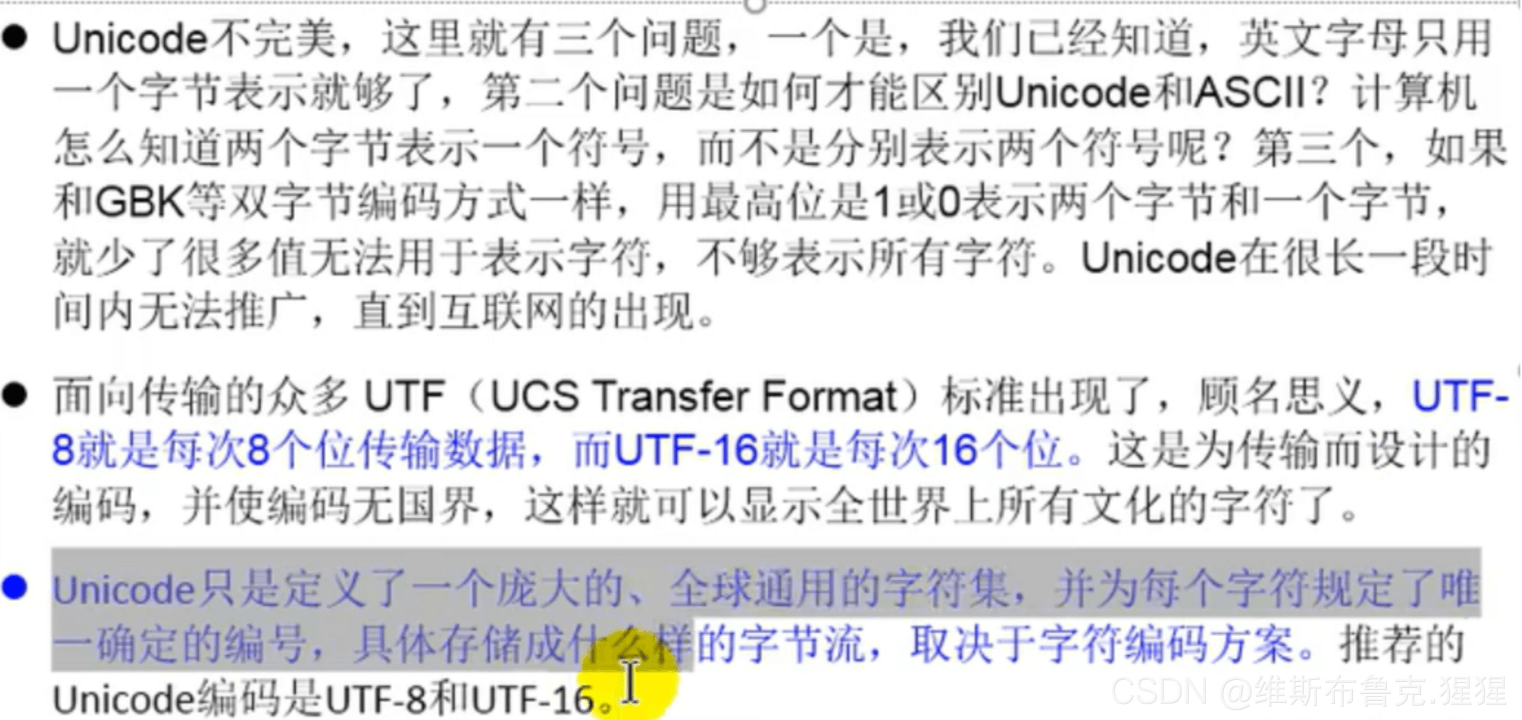
3.其他流
1.标准的输入、输出流
1.1System.in:标准的输入流,默认从键盘输入
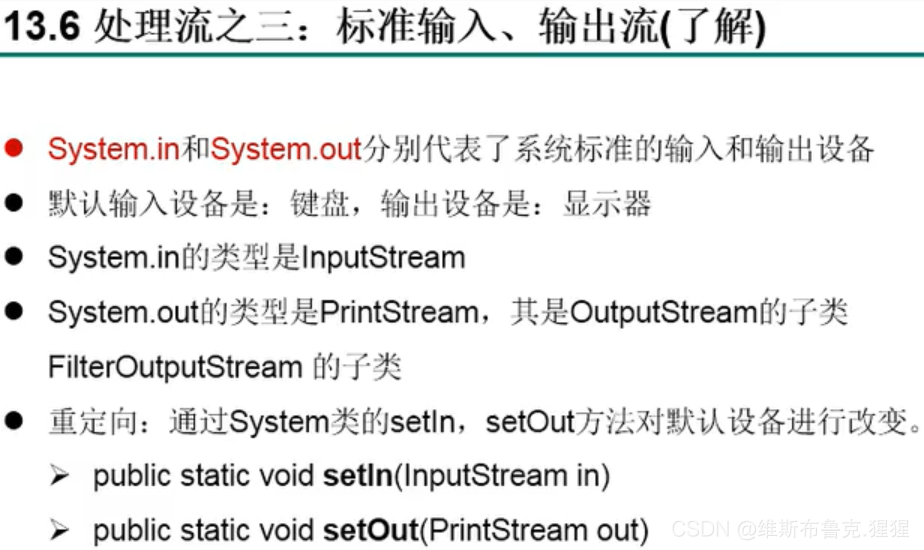
System.out:标准的输入流,默认从控制台输出
1.2System类的setIn() / setOut()方式重新指定输入和输出的流。
修改默认的输入和输出行为:
System类的setIn(InputStream is) / setOut(PrintStream ps)方式重新指定输入和输出的流。
1.3练习:
从键盘输入字符串,要求将读取道德整行字符串转换成大写输出。然后继续进行输入操作。
直至当输入"e"或"exit"时,退出程序
方法一:使用Scanner实现,调用next()返回一个字符串
方法二:使用System.in实现。System.in ---> 转换流 -->BufferedReader的readLine()
public static void main(String[] args) {
BufferedReader br = null;
try {
InputStreamReader isr = new InputStreamReader(System.in);
br = new BufferedReader(isr);
while(true){
System.out.println("请输入字符串:");
String data = br.readLine();//调用此方法读取一行数据
if("e".equalsIgnoreCase(data) || "exit".equalsIgnoreCase(data)){//避免空指针的写法,之前有
System.out.println("程序结束");
break;
}
String upperCase = data.toUpperCase();
System.out.println(upperCase);
}
} catch (IOException e) {
e.printStackTrace();
} finally {
if(br != null){
try {
br.close();
} catch (IOException e) {
e.printStackTrace();
}
}
}
}
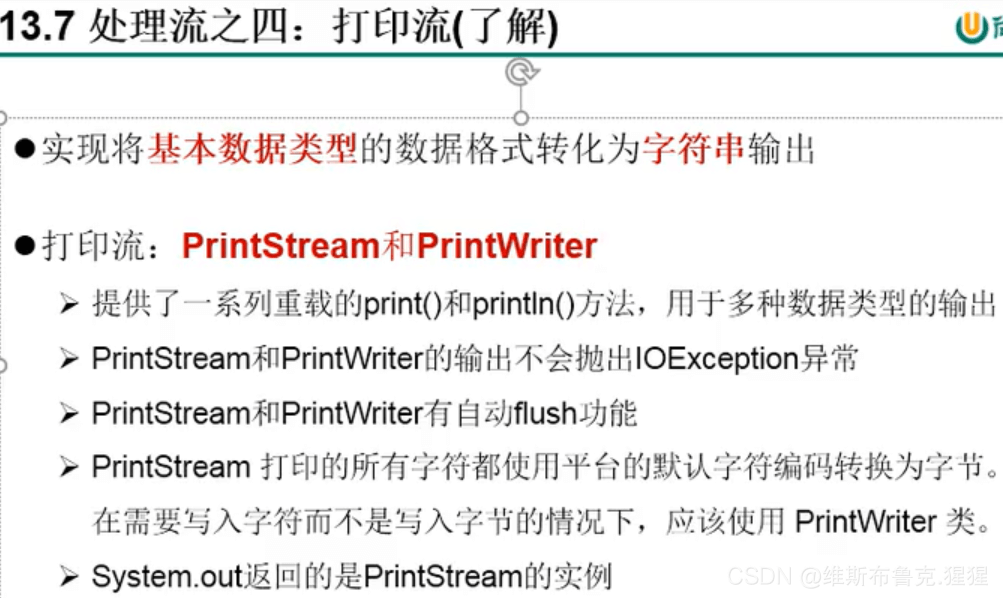

对象流 (重点)
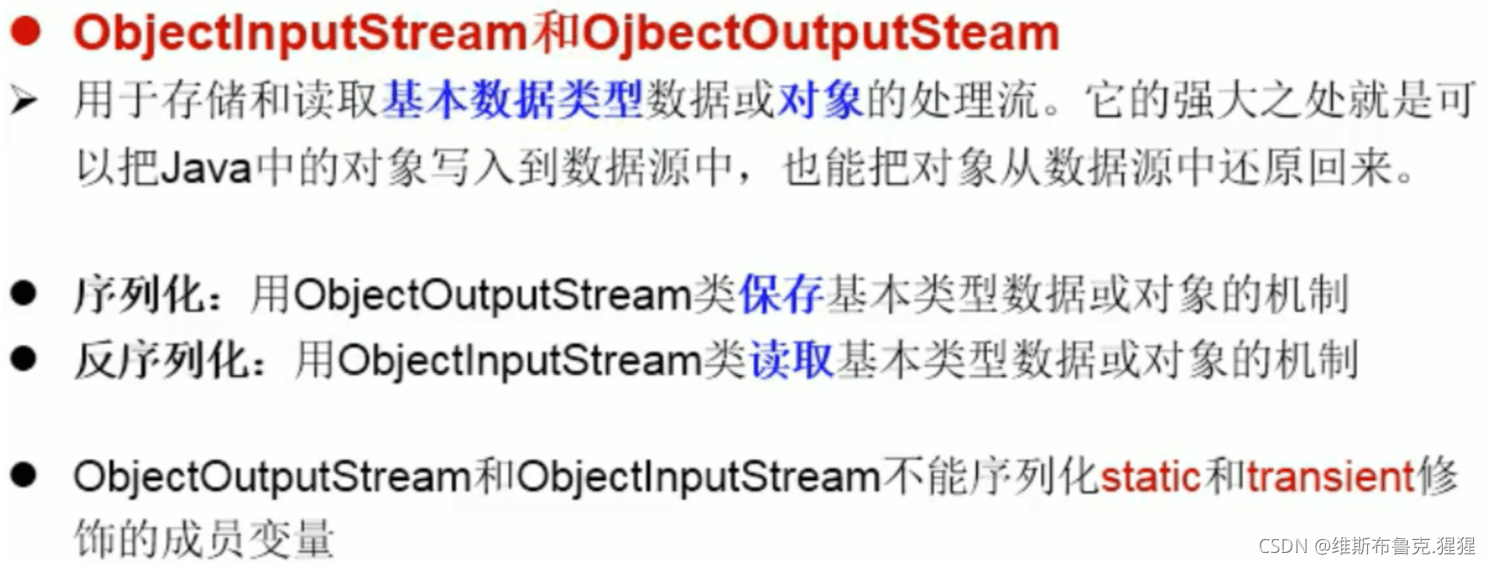
对象流的使用
1.ObjectInputStream和ObjectOutputStream
2.作用:用于存储和读取基本数据类型或对象的处理流。
3.要想一个Java对象是可序列化的,需要满足相应的要求。见Person.java
4.序列化机制:(重点!!!!)
对象序列化机制允许把内存中的Java对象转换成平台无关的二进制流,从而允许把这种二进制流持久的保存在磁盘上,或通过网络将这种
二进制流传输到另一个网络节点,当其他程序获取了这种二进制流,就可以恢复成原来的Java对象
序列化过程:将内存中的java对象保存到磁盘中或通过网络传输出去
使用ObjectOutputStream实现
@Test
public void testObjectOutputStream(){
ObjectOutputStream oos = null;
try {
oos = new ObjectOutputStream(new FileOutputStream("object.dat"));
oos.writeObject(new String("我爱北京天安门"));
oos.flush();//刷新操作
oos.writeObject(new Person("王铭",23));
oos.flush();
} catch (IOException e) {
e.printStackTrace();
} finally {
if(oos != null){
try {
oos.close();
} catch (IOException e) {
e.printStackTrace();
}
}
}
}
反序列化:将磁盘文件中的对象还原为内存中的一个Java对象
使用ObjectInputStream来实现
@Test
public void testObjectInputStream(){
ObjectInputStream ois = null;
try {
ois = new ObjectInputStream(new FileInputStream("object.dat"));
Object obj = ois.readObject();
String str = (String) obj;
Person p = ois.readObject();
System.out.println(str);
System.out.println(p);
}catch(IOException e){
e.printStackTrace();
}catch(ClassNotFoundException e){
e.printStackTrace();
}finally {
if(ois != null){
ois.close;
}
}
}
Person类
Person需要满足如下的要求,方可序列化
1.需要实现接口:Serializable
2.当前类提供一个全局常量:serialVersionUID
3.除了当前Person类需要实现Serializable接口之外,还必须保证其内部所有属性也必须是可序列化的(默认情况下,基本数据类型、String:本身是可序列化的)
补充:ObjectOutputStream 和 ObjectInputStream不能序列化static和transient修饰的成员变量
eg:输出结果:Person{name='null',age=0,id=0,acct=null}
public class Person implements Serializable{
public static final long serialVersionUID = 397497937034L;
private String name;
private int age;
@Override
public String toString() {
return "Person{" +
"name='" + name + '\'' +
", age=" + age +
'}';
}
public String getName() {
return name;
}
public void setName(String name) {
this.name = name;
}
public int getAge() {
return age;
}
public void setAge(int age) {
this.age = age;
}
public Person(String name, int age) {
this.name = name;
this.age = age;
}
public Person() {
}
}
对象的序列化机制

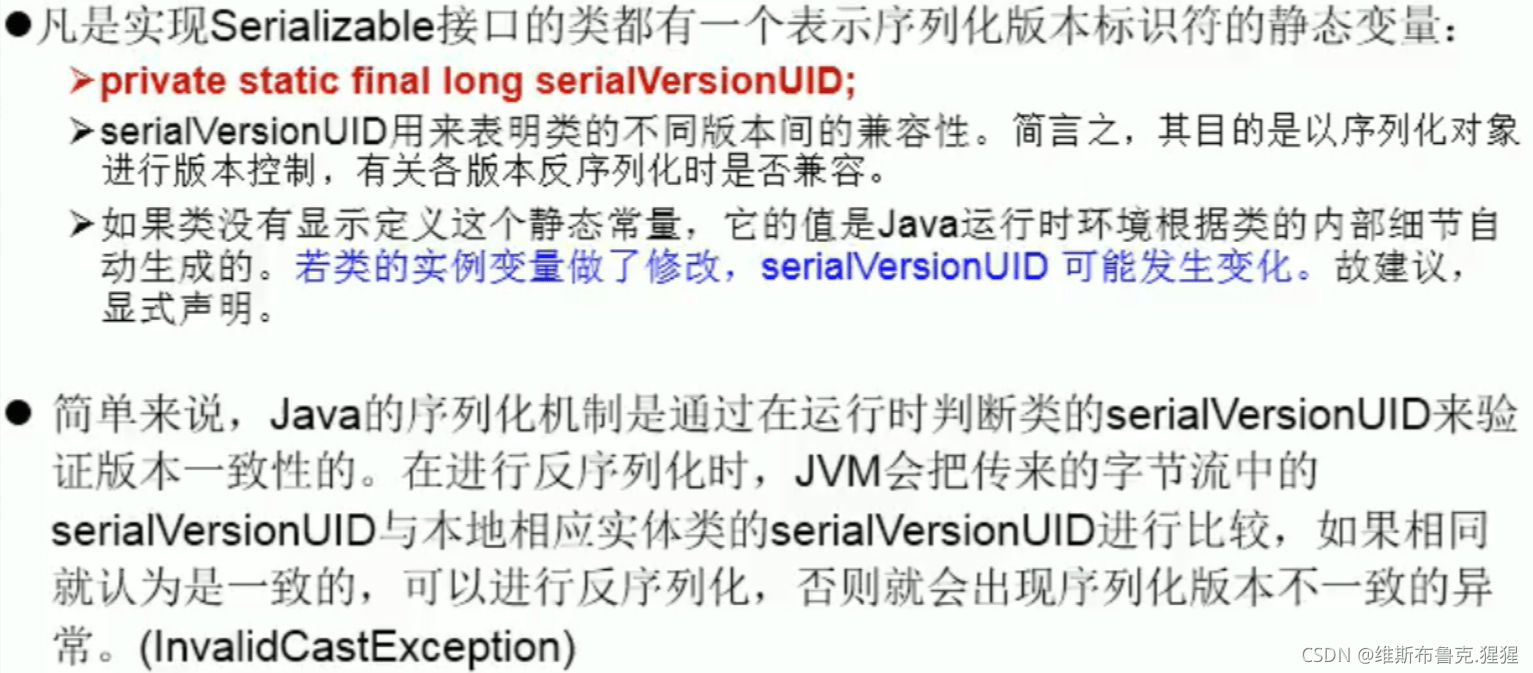
随机存取文件流(了解)

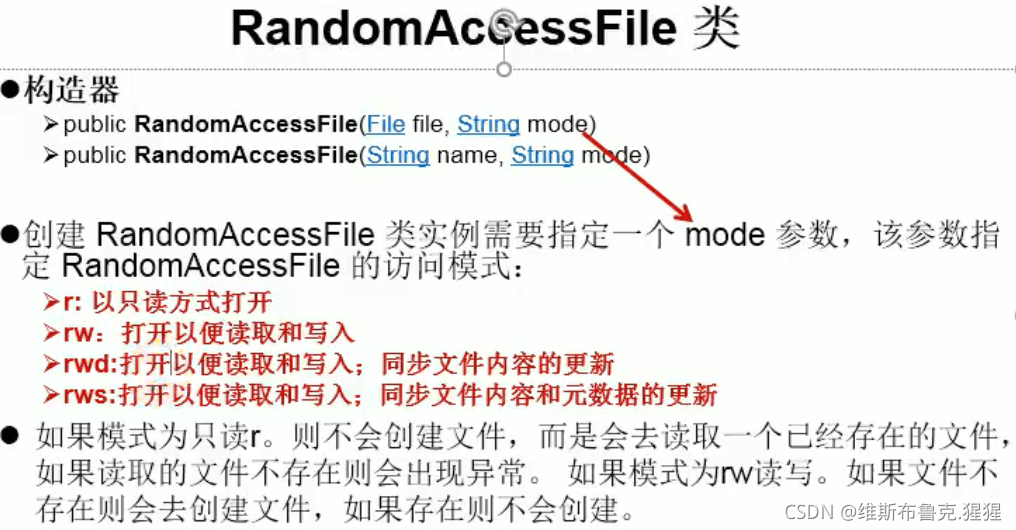

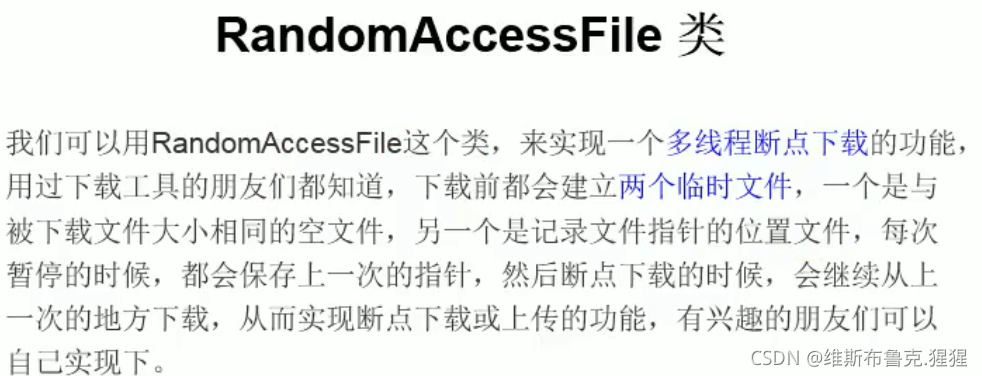
RandomAccessFile
1.RandomAccessFile直接继承于java.lang.Object类,实现了DataInput和DataOutput接口
2.RandomAccessFile既可以作为一个输入流,又可以作为一个输出流
3.如果RandomAccessFile作为输出流时,写出到的文件如果不存在,则在执行过程中自动创建
如果写出到的文件存在,则会对原有文件内容进行覆盖,(默认情况下,从头覆盖)
4.可以通过相关的操作,实现RandomAccessFile"插入"数据的效果
public abstract class RandomAccessFileTest {
@Test
public void test1(){
RandomAccessFile raf1 = null;
RandomAccessFile raf2 = null;
try {
raf1 = new RandomAccessFile(new File("爱情与友情.jpg"), "r");
raf2 = new RandomAccessFile(new File("爱情与友情1.jpg"), "rw");
byte[] buffer = new byte[1024];
int len;
while((len = raf1.read(buffer)) != -1){
raf2.write(buffer,0,len);
}
} catch (IOException e) {
e.printStackTrace();
} finally {
if(raf1 != null){
try {
raf1.close();
} catch (IOException e) {
e.printStackTrace();
}
}
if(raf2 != null){
try {
raf2.close();
} catch (IOException e) {
e.printStackTrace();
}
}
}
}
@Test
public void test2()throws IOException{
RandomAccessFile raf1 = new RandomAccessFile("hello.txt","rw");
raf1.seek(3);//将指针调到角标为3的位置
raf1.write("xyz".getBytes());//
raf1.close();
}
使用RandomAccessFile实现数据的插入效果
@Test
public void test3() throws IOException{
RandomAccessFile raf1 = new RandomAccessFile("hello.txt", "rw");
raf1.seek(3);//将指针调到角标为3的位置
//保存指针3后面的所有数据到StringBuilder中
StringBuilder builder = new StringBuilder((int) new File("hello.txt".length()));
byte[] buffer = new byte[20];
int len;
while((len = raf1.read(buffer)) != -1){
builder.append(new String(buffer,0,len));
}
//调回指针,写入"xyz"
raf1.seek(3);
raf1.write("xyz".getBytes());
//将StringBuilder中的数据写入到文件中
raf1.write(builder.toString().getBytes());
raf1.close();
}
}
Java中的NIO

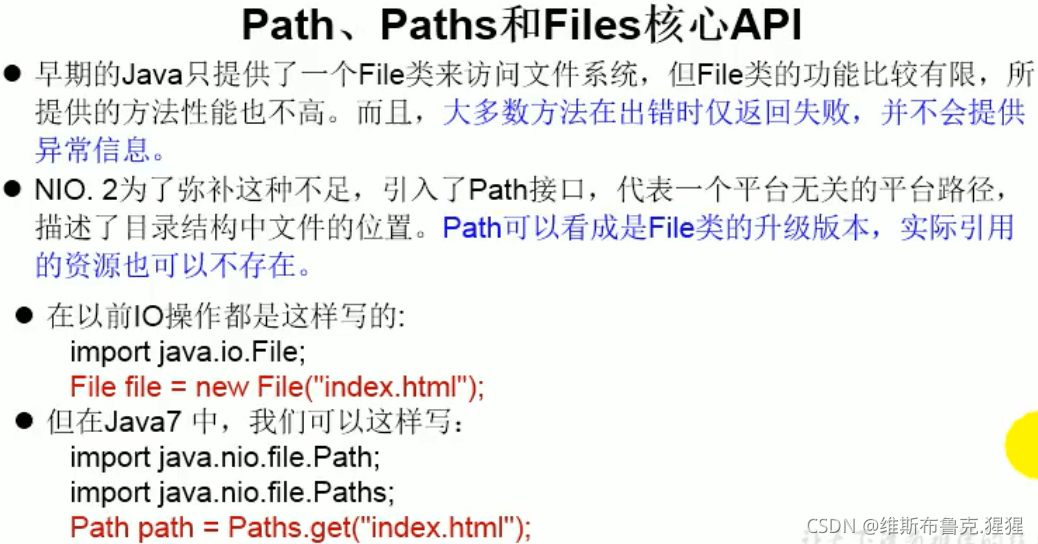
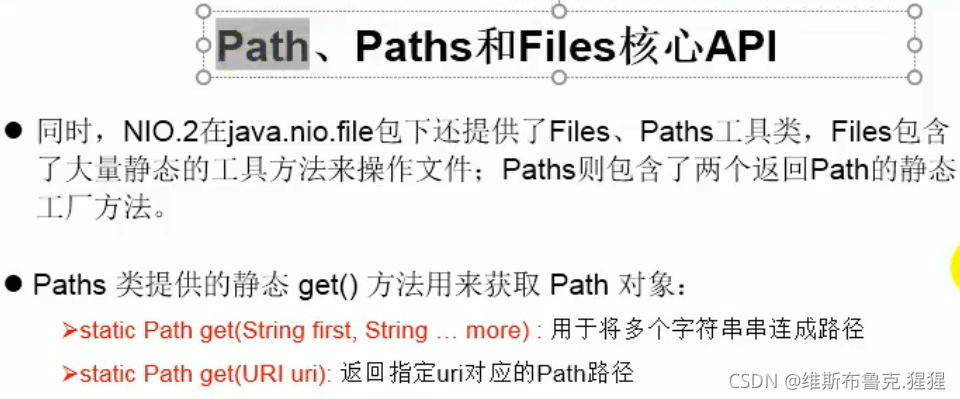
到此这篇关于Java深入浅出说流的使用的文章就介绍到这了,更多相关Java流内容请搜索猪先飞以前的文章或继续浏览下面的相关文章希望大家以后多多支持猪先飞!
相关文章
- 这篇文章主要介绍了如何利用java语言实现经典《复杂迷宫》游戏,文中采用了swing技术进行了界面化处理,感兴趣的小伙伴可以动手试一试...2022-02-01
java 运行报错has been compiled by a more recent version of the Java Runtime
java 运行报错has been compiled by a more recent version of the Java Runtime (class file version 54.0)...2021-04-01- 这篇文章主要介绍了在java中获取List集合中最大的日期时间操作,具有很好的参考价值,希望对大家有所帮助。一起跟随小编过来看看吧...2020-08-15
- 这篇文章主要介绍了教你怎么用Java获取国家法定节假日,文中有非常详细的代码示例,对正在学习java的小伙伴们有非常好的帮助,需要的朋友可以参考下...2021-04-23
- 这篇文章主要介绍了Java如何发起http请求的实现,文中通过示例代码介绍的非常详细,对大家的学习或者工作具有一定的参考学习价值,需要的朋友们下面随着小编来一起学习学习吧...2021-03-31
- 说起C#和Java这两门语言(语法,数据类型 等),个人以为,大概有90%以上的相似,甚至可以认为几乎一样。但是在工作中,我也发现了一些细微的差别...2020-06-25
- 这篇文章主要介绍了解决Java处理HTTP请求超时的问题,具有很好的参考价值,希望对大家有所帮助。一起跟随小编过来看看吧...2021-03-29
- 这篇文章主要介绍了java 判断两个时间段是否重叠的案例,具有很好的参考价值,希望对大家有所帮助。一起跟随小编过来看看吧...2020-08-15
- 这篇文章主要介绍了超简洁java实现双色球若干注随机号码生成(实例代码),本文通过实例代码给大家介绍的非常详细,对大家的学习或工作具有一定的参考借鉴价值,需要的朋友可以参考下...2021-04-02
java 画pdf用itext调整表格宽度、自定义各个列宽的方法
这篇文章主要介绍了java 画pdf用itext调整表格宽度、自定义各个列宽的方法,具有很好的参考价值,希望对大家有所帮助。一起跟随小编过来看看吧...2021-01-31- 这篇文章主要介绍了Java生成随机姓名、性别和年龄的实现示例,文中通过示例代码介绍的非常详细,对大家的学习或者工作具有一定的参考学习价值,需要的朋友们下面随着小编来一起学习学习吧...2020-10-01
- 这篇文章主要介绍了java正则表达式判断前端参数修改表中另一个字段的值,需要的朋友可以参考下...2021-05-07
Java使用ScriptEngine动态执行代码(附Java几种动态执行代码比较)
这篇文章主要介绍了Java使用ScriptEngine动态执行代码,并且分享Java几种动态执行代码比较,需要的朋友可以参考下...2021-04-15- 这篇文章主要介绍了Java开发实现人机猜拳游戏,文中示例代码介绍的非常详细,具有一定的参考价值,感兴趣的小伙伴们可以参考一下...2020-08-03
- 这篇文章主要介绍了Java List集合返回值去掉中括号('[ ]')的操作,具有很好的参考价值,希望对大家有所帮助。一起跟随小编过来看看吧...2020-08-29
Java中lombok的@Builder注解的解析与简单使用详解
这篇文章主要介绍了Java中lombok的@Builder注解的解析与简单使用,本文给大家介绍的非常详细,对大家的学习或工作具有一定的参考借鉴价值,需要的朋友可以参考下...2021-01-06- 下面小编就为大家带来一篇java中String类型变量的赋值问题介绍。小编觉得挺不错的。现在分享给大家,给大家一个参考。...2016-03-28
Java 8 Stream 的终极技巧——Collectors 功能与操作方法详解
这篇文章主要介绍了Java 8 Stream Collectors 功能与操作方法,结合实例形式详细分析了Java 8 Stream Collectors 功能、操作方法及相关注意事项,需要的朋友可以参考下...2020-05-20- 本文主要介绍用C#实现图片转换成字节流,字节流转换成图片,并根据图片路径返回图片的字节流,有需要的朋友可以参考下...2020-06-25
- 这篇文章主要介绍了Java线程池中的各个参数如何合理设置操作,具有很好的参考价值,希望对大家有所帮助。如有错误或未考虑完全的地方,望不吝赐教...2021-06-19
